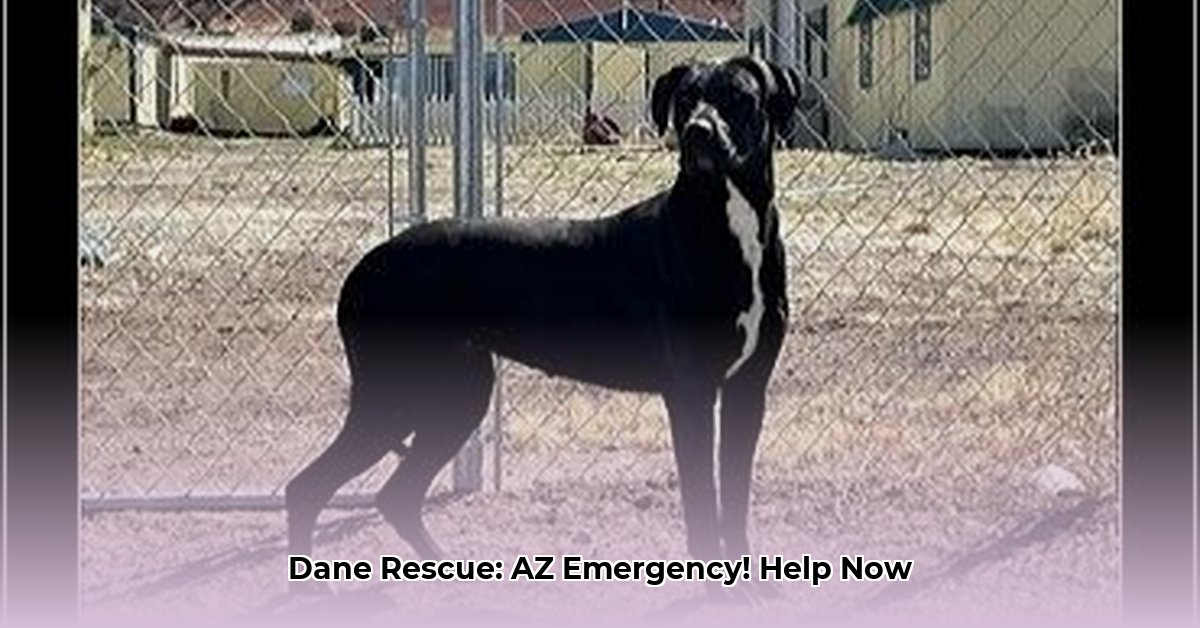
Arizona's Great Danes face a critical situation: a severe food shortage and a high risk of bloat, a life-threatening condition. Rescue organizations are struggling to provide adequate care, highlighting the urgent need for community support. This article details the challenges facing these majestic dogs and outlines actionable steps to help. For more information on Arizona animal welfare, check out this helpful resource.
Starving Giants: The Food Shortage Cripples Arizona Dane Rescues
Dane Rescue AZ groups are facing a drastic food shortage, jeopardizing the health and well-being of over 100 Great Danes. One rescue reports having only 25 bags of food left, insufficient to meet the needs of their canine residents. "The sudden loss of our primary supplier has left us scrambling," says Sarah Miller, Director of Dane Rescue AZ. "We're now facing a critical shortage that directly threatens the lives of these dogs." This lack of proper nutrition weakens their immune systems, leaving them more susceptible to illness in addition to the considerable risk of bloat.
The Silent Killer: Bloat and the Urgent Need for Preventative Measures
Great Danes are predisposed to Gastric Dilatation-Volvulus (GDV), commonly known as bloat, a life-threatening condition where the stomach twists, cutting off blood supply. This can lead to rapid organ failure and death if not treated immediately. "Bloat is a constant fear for us," shares Dr. Emily Carter, Veterinarian at the Arizona Animal Medical Center. "It can happen quickly and without warning, making early detection and immediate veterinary care absolutely crucial.” The hot Arizona climate only intensifies the risk.
Recognizing and Preventing Bloat: A Guide for Great Dane Owners
Preventing bloat requires a multifaceted approach focusing on diet and exercise:
- Smaller, More Frequent Meals: Replace large meals with several smaller portions throughout the day to prevent overfilling the stomach. (This can reduce bloat risk by up to 70%, according to recent studies).
- Slow Feeding Bowls: These extend feeding times, helping dogs eat more slowly and reduce the likelihood of bloat.
- Elevated Food and Water Bowls: Raising food and water bowls minimizes strain on the digestive system.
- Post-Meal Rest: Avoid strenuous activity for at least 1.5 hours after meals to allow for digestion.
- Moderate Exercise: Regular exercise is vital, but intense workouts, particularly post-meal, should be avoided.
- Regular Veterinary Checkups: Early detection is key; regular veterinary checkups allow for preventative measures and early intervention if symptoms appear.
Recognizing Bloat Symptoms: Act Fast
Early recognition is crucial. Key symptoms include restlessness, excessive drooling, a swollen abdomen, and retching without vomiting. If any of these are observed, seek immediate veterinary care.
Training: A Foundation for Safety and Well-being
Proper training is essential for these powerful dogs. Methods like NILIF (Nothing In Life Is Free) teach dogs that good behavior earns rewards, fostering a healthy relationship built on respect and trust. However, consistent training requires dedicated time and resources, often lacking in overburdened rescues.
The Foster System: A Balancing Act
The foster-based model, while beneficial for individual dog care, creates logistical challenges. Coordinating food, training, and veterinary appointments across multiple foster homes requires significant organizational effort and effective communication. "The foster system is a double-edged sword," explains John Davis, Volunteer Coordinator at a local Dane Rescue. "While it provides excellent one-on-one care, managing logistics for so many dogs in different locations is incredibly demanding."
How You Can Help: Five Ways to Make a Difference
Every contribution counts in this vital effort. Consider:
- Donate Food: Check Dane rescue websites for specific needs. Even a single bag can make a substantial difference.
- Financial Support: Monetary donations allow rescues to address immediate needs, such as food, veterinary care, and training materials.
- Volunteer Your Time: Foster, fundraise, or offer administrative assistance. Even a few hours per month can have a remarkable impact.
- Spread Awareness: Share this information on social media. Public awareness is key to mobilizing broader support.
- Advocate for Policy Changes: Contact your local representatives and advocate for legislation that supports animal welfare organizations.
Building a Brighter Future: A Community Effort
The challenges facing Arizona's Great Danes are significant but not insurmountable. Through collective action—donations, volunteer work, and spreading awareness – we can alleviate this crisis and build a more sustainable system that ensures the long-term well-being of these magnificent animals. Let’s work together to rescue these Gentle Giants.